Brand Management Report: Analysis of Branding Strategies
VerifiedAdded on 2023/01/13
|16
|5176
|98
Report
AI Summary
This report examines the core concepts of brand management, using Next Plc as a case study to illustrate key principles. The report begins with an introduction to brand management, emphasizing its importance as a marketing tool and analyzing the essential components of a successful brand strategy. It then delves into brand equity, exploring models like Keller's Customer-Based Brand Equity (CBBE) and strategies for building, extending, reinforcing, and revitalizing brands. The report further analyzes brand portfolio management, illustrating brand hierarchy and the use of various management strategies. It then evaluates different techniques of brand extension and brand leverage in domestic and international markets. Finally, the report assesses techniques for measuring brand value, awareness, market share, consumer attitudes, purchasing intent, and brand equity, including brand audit and tracking techniques. The report provides a comprehensive overview of the key aspects of brand management, offering insights into how brands are built, managed, and sustained in a competitive market.

Brand Management
1
1
Paraphrase This Document
Need a fresh take? Get an instant paraphrase of this document with our AI Paraphraser
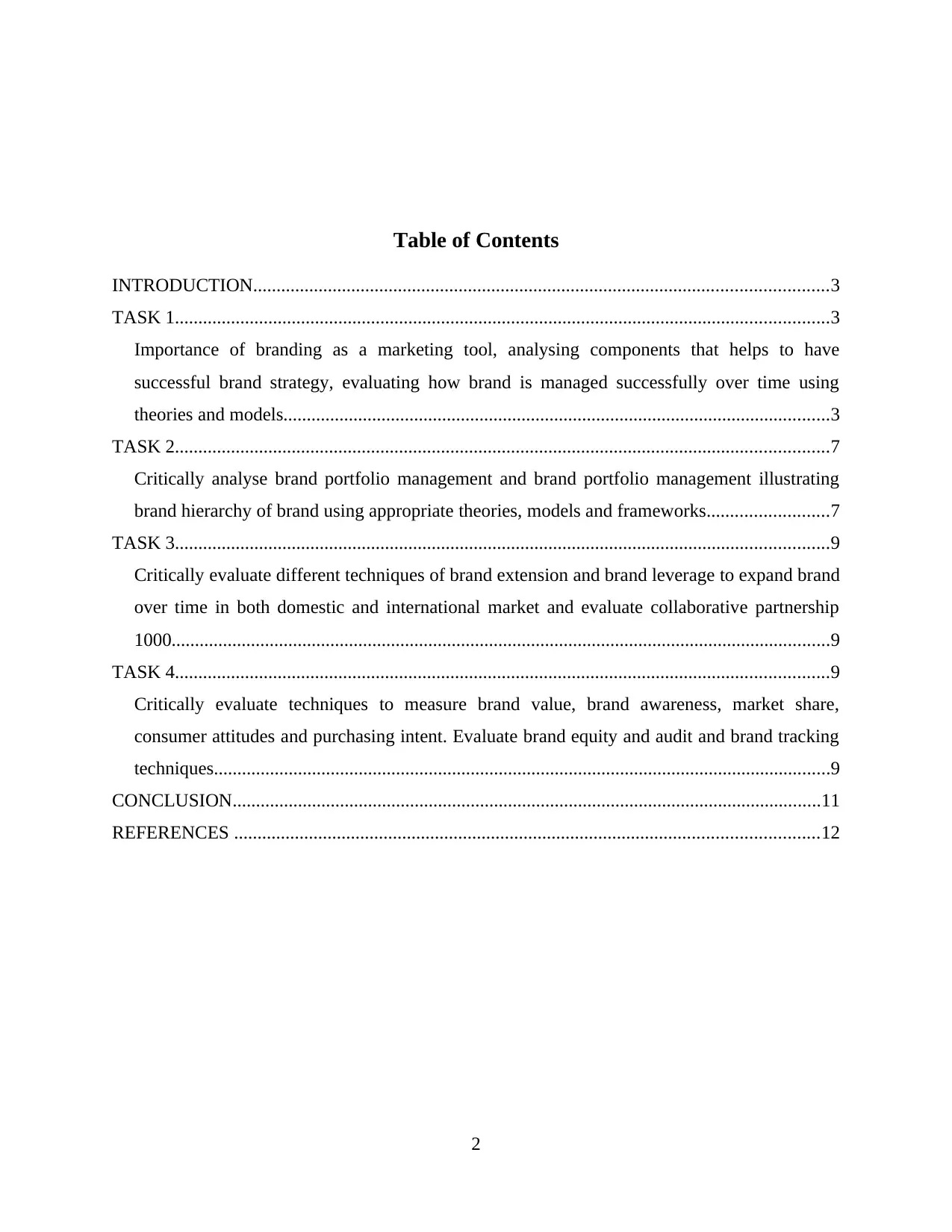
Table of Contents
INTRODUCTION...........................................................................................................................3
TASK 1............................................................................................................................................3
Importance of branding as a marketing tool, analysing components that helps to have
successful brand strategy, evaluating how brand is managed successfully over time using
theories and models.....................................................................................................................3
TASK 2............................................................................................................................................7
Critically analyse brand portfolio management and brand portfolio management illustrating
brand hierarchy of brand using appropriate theories, models and frameworks..........................7
TASK 3............................................................................................................................................9
Critically evaluate different techniques of brand extension and brand leverage to expand brand
over time in both domestic and international market and evaluate collaborative partnership
1000.............................................................................................................................................9
TASK 4............................................................................................................................................9
Critically evaluate techniques to measure brand value, brand awareness, market share,
consumer attitudes and purchasing intent. Evaluate brand equity and audit and brand tracking
techniques....................................................................................................................................9
CONCLUSION..............................................................................................................................11
REFERENCES .............................................................................................................................12
2
INTRODUCTION...........................................................................................................................3
TASK 1............................................................................................................................................3
Importance of branding as a marketing tool, analysing components that helps to have
successful brand strategy, evaluating how brand is managed successfully over time using
theories and models.....................................................................................................................3
TASK 2............................................................................................................................................7
Critically analyse brand portfolio management and brand portfolio management illustrating
brand hierarchy of brand using appropriate theories, models and frameworks..........................7
TASK 3............................................................................................................................................9
Critically evaluate different techniques of brand extension and brand leverage to expand brand
over time in both domestic and international market and evaluate collaborative partnership
1000.............................................................................................................................................9
TASK 4............................................................................................................................................9
Critically evaluate techniques to measure brand value, brand awareness, market share,
consumer attitudes and purchasing intent. Evaluate brand equity and audit and brand tracking
techniques....................................................................................................................................9
CONCLUSION..............................................................................................................................11
REFERENCES .............................................................................................................................12
2
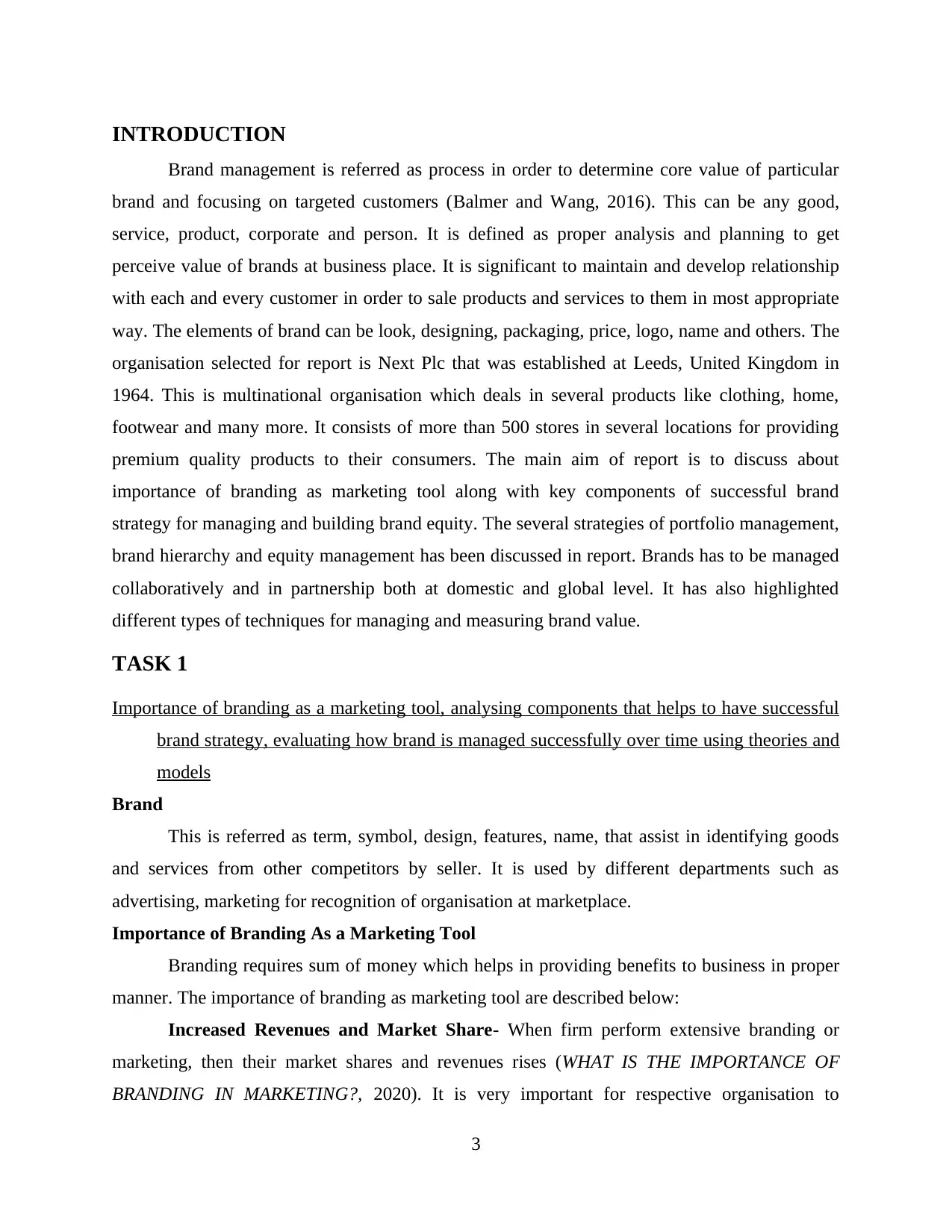
INTRODUCTION
Brand management is referred as process in order to determine core value of particular
brand and focusing on targeted customers (Balmer and Wang, 2016). This can be any good,
service, product, corporate and person. It is defined as proper analysis and planning to get
perceive value of brands at business place. It is significant to maintain and develop relationship
with each and every customer in order to sale products and services to them in most appropriate
way. The elements of brand can be look, designing, packaging, price, logo, name and others. The
organisation selected for report is Next Plc that was established at Leeds, United Kingdom in
1964. This is multinational organisation which deals in several products like clothing, home,
footwear and many more. It consists of more than 500 stores in several locations for providing
premium quality products to their consumers. The main aim of report is to discuss about
importance of branding as marketing tool along with key components of successful brand
strategy for managing and building brand equity. The several strategies of portfolio management,
brand hierarchy and equity management has been discussed in report. Brands has to be managed
collaboratively and in partnership both at domestic and global level. It has also highlighted
different types of techniques for managing and measuring brand value.
TASK 1
Importance of branding as a marketing tool, analysing components that helps to have successful
brand strategy, evaluating how brand is managed successfully over time using theories and
models
Brand
This is referred as term, symbol, design, features, name, that assist in identifying goods
and services from other competitors by seller. It is used by different departments such as
advertising, marketing for recognition of organisation at marketplace.
Importance of Branding As a Marketing Tool
Branding requires sum of money which helps in providing benefits to business in proper
manner. The importance of branding as marketing tool are described below:
Increased Revenues and Market Share- When firm perform extensive branding or
marketing, then their market shares and revenues rises (WHAT IS THE IMPORTANCE OF
BRANDING IN MARKETING?, 2020). It is very important for respective organisation to
3
Brand management is referred as process in order to determine core value of particular
brand and focusing on targeted customers (Balmer and Wang, 2016). This can be any good,
service, product, corporate and person. It is defined as proper analysis and planning to get
perceive value of brands at business place. It is significant to maintain and develop relationship
with each and every customer in order to sale products and services to them in most appropriate
way. The elements of brand can be look, designing, packaging, price, logo, name and others. The
organisation selected for report is Next Plc that was established at Leeds, United Kingdom in
1964. This is multinational organisation which deals in several products like clothing, home,
footwear and many more. It consists of more than 500 stores in several locations for providing
premium quality products to their consumers. The main aim of report is to discuss about
importance of branding as marketing tool along with key components of successful brand
strategy for managing and building brand equity. The several strategies of portfolio management,
brand hierarchy and equity management has been discussed in report. Brands has to be managed
collaboratively and in partnership both at domestic and global level. It has also highlighted
different types of techniques for managing and measuring brand value.
TASK 1
Importance of branding as a marketing tool, analysing components that helps to have successful
brand strategy, evaluating how brand is managed successfully over time using theories and
models
Brand
This is referred as term, symbol, design, features, name, that assist in identifying goods
and services from other competitors by seller. It is used by different departments such as
advertising, marketing for recognition of organisation at marketplace.
Importance of Branding As a Marketing Tool
Branding requires sum of money which helps in providing benefits to business in proper
manner. The importance of branding as marketing tool are described below:
Increased Revenues and Market Share- When firm perform extensive branding or
marketing, then their market shares and revenues rises (WHAT IS THE IMPORTANCE OF
BRANDING IN MARKETING?, 2020). It is very important for respective organisation to
3
⊘ This is a preview!⊘
Do you want full access?
Subscribe today to unlock all pages.

Trusted by 1+ million students worldwide
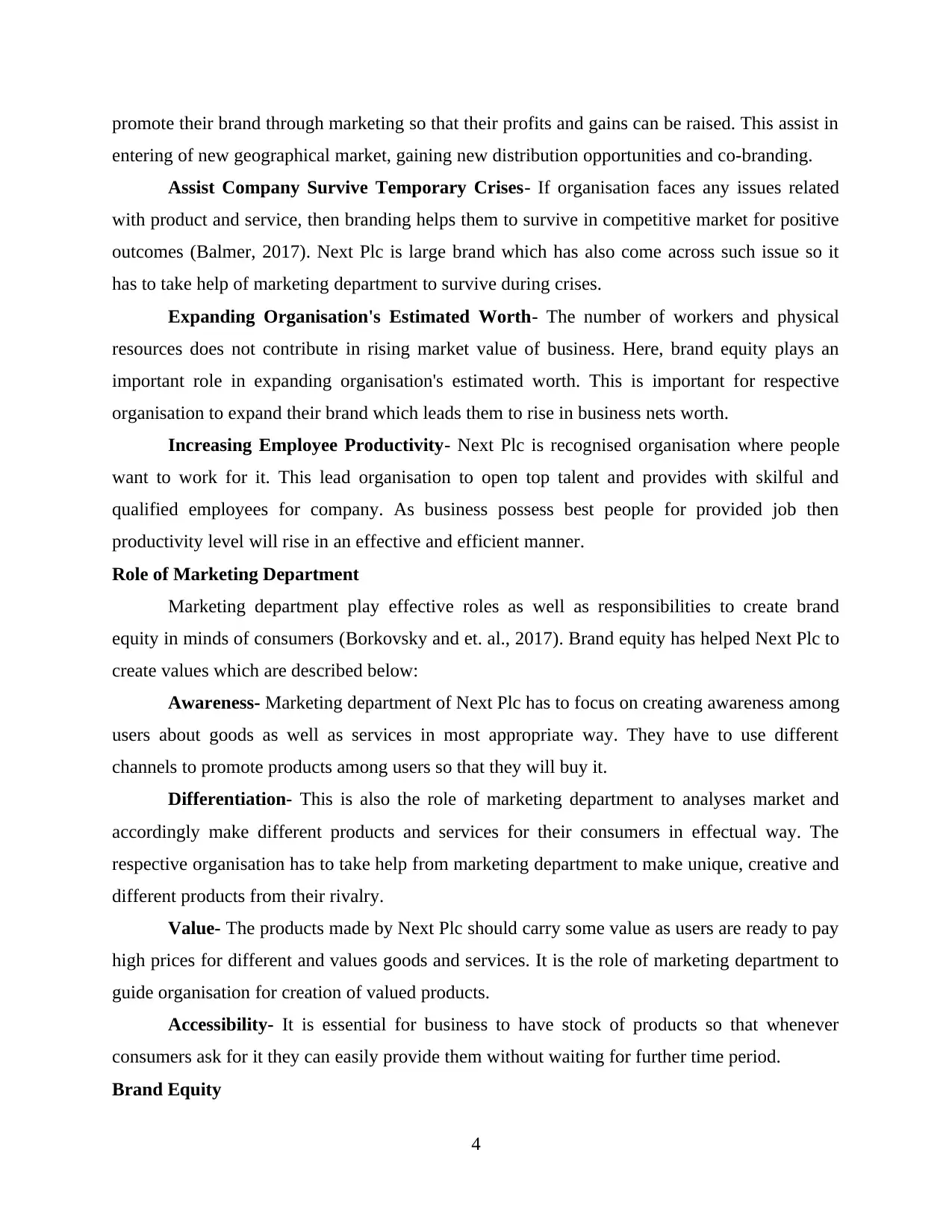
promote their brand through marketing so that their profits and gains can be raised. This assist in
entering of new geographical market, gaining new distribution opportunities and co-branding.
Assist Company Survive Temporary Crises- If organisation faces any issues related
with product and service, then branding helps them to survive in competitive market for positive
outcomes (Balmer, 2017). Next Plc is large brand which has also come across such issue so it
has to take help of marketing department to survive during crises.
Expanding Organisation's Estimated Worth- The number of workers and physical
resources does not contribute in rising market value of business. Here, brand equity plays an
important role in expanding organisation's estimated worth. This is important for respective
organisation to expand their brand which leads them to rise in business nets worth.
Increasing Employee Productivity- Next Plc is recognised organisation where people
want to work for it. This lead organisation to open top talent and provides with skilful and
qualified employees for company. As business possess best people for provided job then
productivity level will rise in an effective and efficient manner.
Role of Marketing Department
Marketing department play effective roles as well as responsibilities to create brand
equity in minds of consumers (Borkovsky and et. al., 2017). Brand equity has helped Next Plc to
create values which are described below:
Awareness- Marketing department of Next Plc has to focus on creating awareness among
users about goods as well as services in most appropriate way. They have to use different
channels to promote products among users so that they will buy it.
Differentiation- This is also the role of marketing department to analyses market and
accordingly make different products and services for their consumers in effectual way. The
respective organisation has to take help from marketing department to make unique, creative and
different products from their rivalry.
Value- The products made by Next Plc should carry some value as users are ready to pay
high prices for different and values goods and services. It is the role of marketing department to
guide organisation for creation of valued products.
Accessibility- It is essential for business to have stock of products so that whenever
consumers ask for it they can easily provide them without waiting for further time period.
Brand Equity
4
entering of new geographical market, gaining new distribution opportunities and co-branding.
Assist Company Survive Temporary Crises- If organisation faces any issues related
with product and service, then branding helps them to survive in competitive market for positive
outcomes (Balmer, 2017). Next Plc is large brand which has also come across such issue so it
has to take help of marketing department to survive during crises.
Expanding Organisation's Estimated Worth- The number of workers and physical
resources does not contribute in rising market value of business. Here, brand equity plays an
important role in expanding organisation's estimated worth. This is important for respective
organisation to expand their brand which leads them to rise in business nets worth.
Increasing Employee Productivity- Next Plc is recognised organisation where people
want to work for it. This lead organisation to open top talent and provides with skilful and
qualified employees for company. As business possess best people for provided job then
productivity level will rise in an effective and efficient manner.
Role of Marketing Department
Marketing department play effective roles as well as responsibilities to create brand
equity in minds of consumers (Borkovsky and et. al., 2017). Brand equity has helped Next Plc to
create values which are described below:
Awareness- Marketing department of Next Plc has to focus on creating awareness among
users about goods as well as services in most appropriate way. They have to use different
channels to promote products among users so that they will buy it.
Differentiation- This is also the role of marketing department to analyses market and
accordingly make different products and services for their consumers in effectual way. The
respective organisation has to take help from marketing department to make unique, creative and
different products from their rivalry.
Value- The products made by Next Plc should carry some value as users are ready to pay
high prices for different and values goods and services. It is the role of marketing department to
guide organisation for creation of valued products.
Accessibility- It is essential for business to have stock of products so that whenever
consumers ask for it they can easily provide them without waiting for further time period.
Brand Equity
4
Paraphrase This Document
Need a fresh take? Get an instant paraphrase of this document with our AI Paraphraser
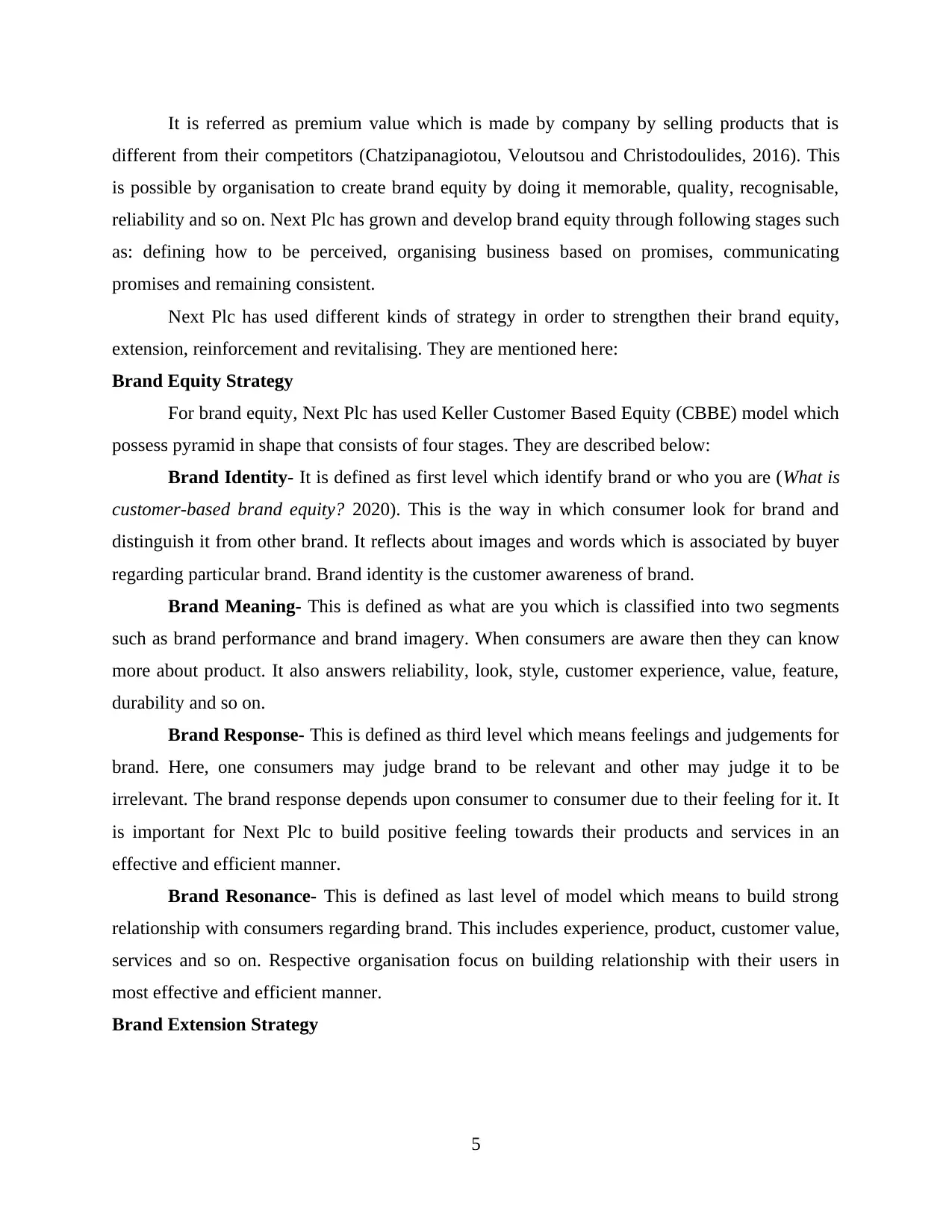
It is referred as premium value which is made by company by selling products that is
different from their competitors (Chatzipanagiotou, Veloutsou and Christodoulides, 2016). This
is possible by organisation to create brand equity by doing it memorable, quality, recognisable,
reliability and so on. Next Plc has grown and develop brand equity through following stages such
as: defining how to be perceived, organising business based on promises, communicating
promises and remaining consistent.
Next Plc has used different kinds of strategy in order to strengthen their brand equity,
extension, reinforcement and revitalising. They are mentioned here:
Brand Equity Strategy
For brand equity, Next Plc has used Keller Customer Based Equity (CBBE) model which
possess pyramid in shape that consists of four stages. They are described below:
Brand Identity- It is defined as first level which identify brand or who you are (What is
customer-based brand equity? 2020). This is the way in which consumer look for brand and
distinguish it from other brand. It reflects about images and words which is associated by buyer
regarding particular brand. Brand identity is the customer awareness of brand.
Brand Meaning- This is defined as what are you which is classified into two segments
such as brand performance and brand imagery. When consumers are aware then they can know
more about product. It also answers reliability, look, style, customer experience, value, feature,
durability and so on.
Brand Response- This is defined as third level which means feelings and judgements for
brand. Here, one consumers may judge brand to be relevant and other may judge it to be
irrelevant. The brand response depends upon consumer to consumer due to their feeling for it. It
is important for Next Plc to build positive feeling towards their products and services in an
effective and efficient manner.
Brand Resonance- This is defined as last level of model which means to build strong
relationship with consumers regarding brand. This includes experience, product, customer value,
services and so on. Respective organisation focus on building relationship with their users in
most effective and efficient manner.
Brand Extension Strategy
5
different from their competitors (Chatzipanagiotou, Veloutsou and Christodoulides, 2016). This
is possible by organisation to create brand equity by doing it memorable, quality, recognisable,
reliability and so on. Next Plc has grown and develop brand equity through following stages such
as: defining how to be perceived, organising business based on promises, communicating
promises and remaining consistent.
Next Plc has used different kinds of strategy in order to strengthen their brand equity,
extension, reinforcement and revitalising. They are mentioned here:
Brand Equity Strategy
For brand equity, Next Plc has used Keller Customer Based Equity (CBBE) model which
possess pyramid in shape that consists of four stages. They are described below:
Brand Identity- It is defined as first level which identify brand or who you are (What is
customer-based brand equity? 2020). This is the way in which consumer look for brand and
distinguish it from other brand. It reflects about images and words which is associated by buyer
regarding particular brand. Brand identity is the customer awareness of brand.
Brand Meaning- This is defined as what are you which is classified into two segments
such as brand performance and brand imagery. When consumers are aware then they can know
more about product. It also answers reliability, look, style, customer experience, value, feature,
durability and so on.
Brand Response- This is defined as third level which means feelings and judgements for
brand. Here, one consumers may judge brand to be relevant and other may judge it to be
irrelevant. The brand response depends upon consumer to consumer due to their feeling for it. It
is important for Next Plc to build positive feeling towards their products and services in an
effective and efficient manner.
Brand Resonance- This is defined as last level of model which means to build strong
relationship with consumers regarding brand. This includes experience, product, customer value,
services and so on. Respective organisation focus on building relationship with their users in
most effective and efficient manner.
Brand Extension Strategy
5
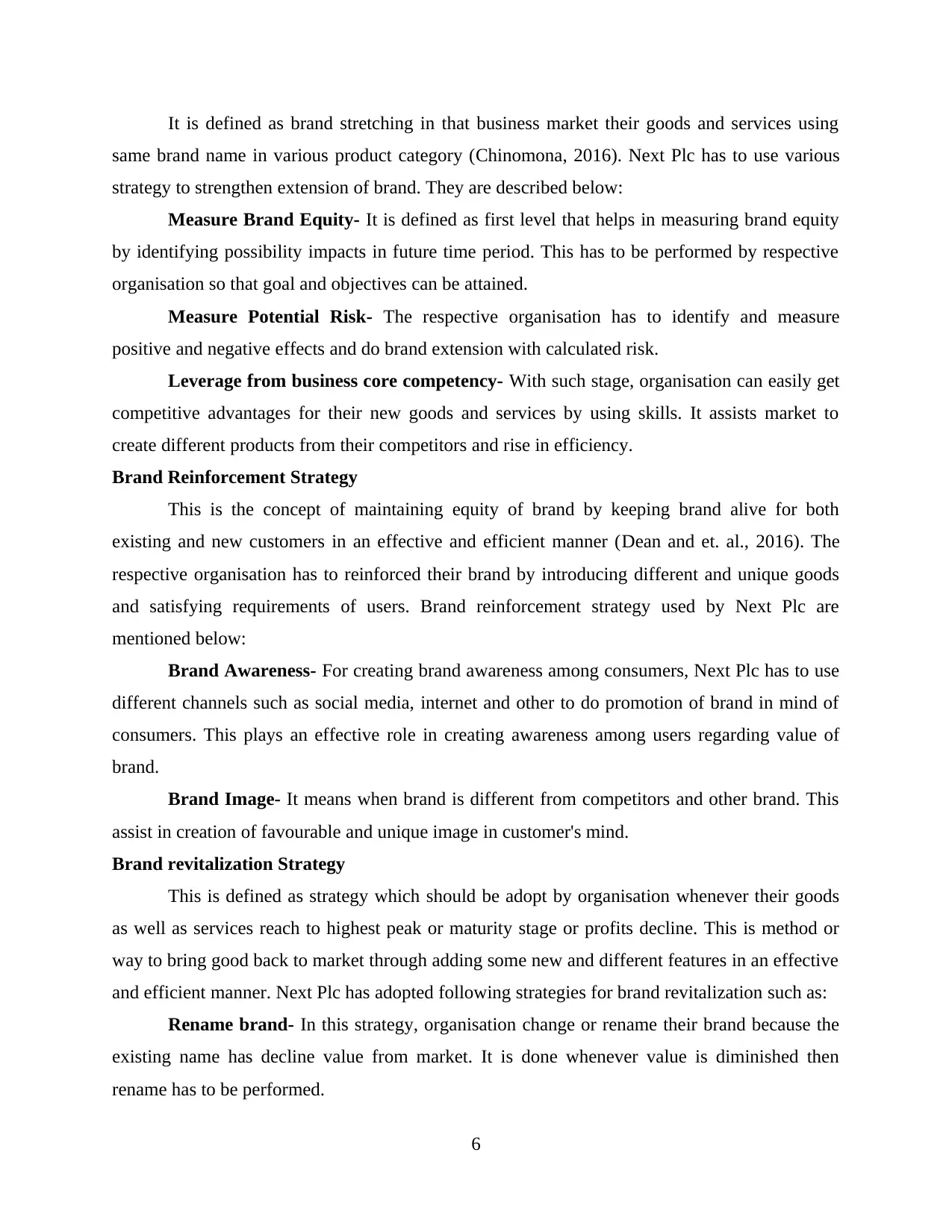
It is defined as brand stretching in that business market their goods and services using
same brand name in various product category (Chinomona, 2016). Next Plc has to use various
strategy to strengthen extension of brand. They are described below:
Measure Brand Equity- It is defined as first level that helps in measuring brand equity
by identifying possibility impacts in future time period. This has to be performed by respective
organisation so that goal and objectives can be attained.
Measure Potential Risk- The respective organisation has to identify and measure
positive and negative effects and do brand extension with calculated risk.
Leverage from business core competency- With such stage, organisation can easily get
competitive advantages for their new goods and services by using skills. It assists market to
create different products from their competitors and rise in efficiency.
Brand Reinforcement Strategy
This is the concept of maintaining equity of brand by keeping brand alive for both
existing and new customers in an effective and efficient manner (Dean and et. al., 2016). The
respective organisation has to reinforced their brand by introducing different and unique goods
and satisfying requirements of users. Brand reinforcement strategy used by Next Plc are
mentioned below:
Brand Awareness- For creating brand awareness among consumers, Next Plc has to use
different channels such as social media, internet and other to do promotion of brand in mind of
consumers. This plays an effective role in creating awareness among users regarding value of
brand.
Brand Image- It means when brand is different from competitors and other brand. This
assist in creation of favourable and unique image in customer's mind.
Brand revitalization Strategy
This is defined as strategy which should be adopt by organisation whenever their goods
as well as services reach to highest peak or maturity stage or profits decline. This is method or
way to bring good back to market through adding some new and different features in an effective
and efficient manner. Next Plc has adopted following strategies for brand revitalization such as:
Rename brand- In this strategy, organisation change or rename their brand because the
existing name has decline value from market. It is done whenever value is diminished then
rename has to be performed.
6
same brand name in various product category (Chinomona, 2016). Next Plc has to use various
strategy to strengthen extension of brand. They are described below:
Measure Brand Equity- It is defined as first level that helps in measuring brand equity
by identifying possibility impacts in future time period. This has to be performed by respective
organisation so that goal and objectives can be attained.
Measure Potential Risk- The respective organisation has to identify and measure
positive and negative effects and do brand extension with calculated risk.
Leverage from business core competency- With such stage, organisation can easily get
competitive advantages for their new goods and services by using skills. It assists market to
create different products from their competitors and rise in efficiency.
Brand Reinforcement Strategy
This is the concept of maintaining equity of brand by keeping brand alive for both
existing and new customers in an effective and efficient manner (Dean and et. al., 2016). The
respective organisation has to reinforced their brand by introducing different and unique goods
and satisfying requirements of users. Brand reinforcement strategy used by Next Plc are
mentioned below:
Brand Awareness- For creating brand awareness among consumers, Next Plc has to use
different channels such as social media, internet and other to do promotion of brand in mind of
consumers. This plays an effective role in creating awareness among users regarding value of
brand.
Brand Image- It means when brand is different from competitors and other brand. This
assist in creation of favourable and unique image in customer's mind.
Brand revitalization Strategy
This is defined as strategy which should be adopt by organisation whenever their goods
as well as services reach to highest peak or maturity stage or profits decline. This is method or
way to bring good back to market through adding some new and different features in an effective
and efficient manner. Next Plc has adopted following strategies for brand revitalization such as:
Rename brand- In this strategy, organisation change or rename their brand because the
existing name has decline value from market. It is done whenever value is diminished then
rename has to be performed.
6
⊘ This is a preview!⊘
Do you want full access?
Subscribe today to unlock all pages.

Trusted by 1+ million students worldwide
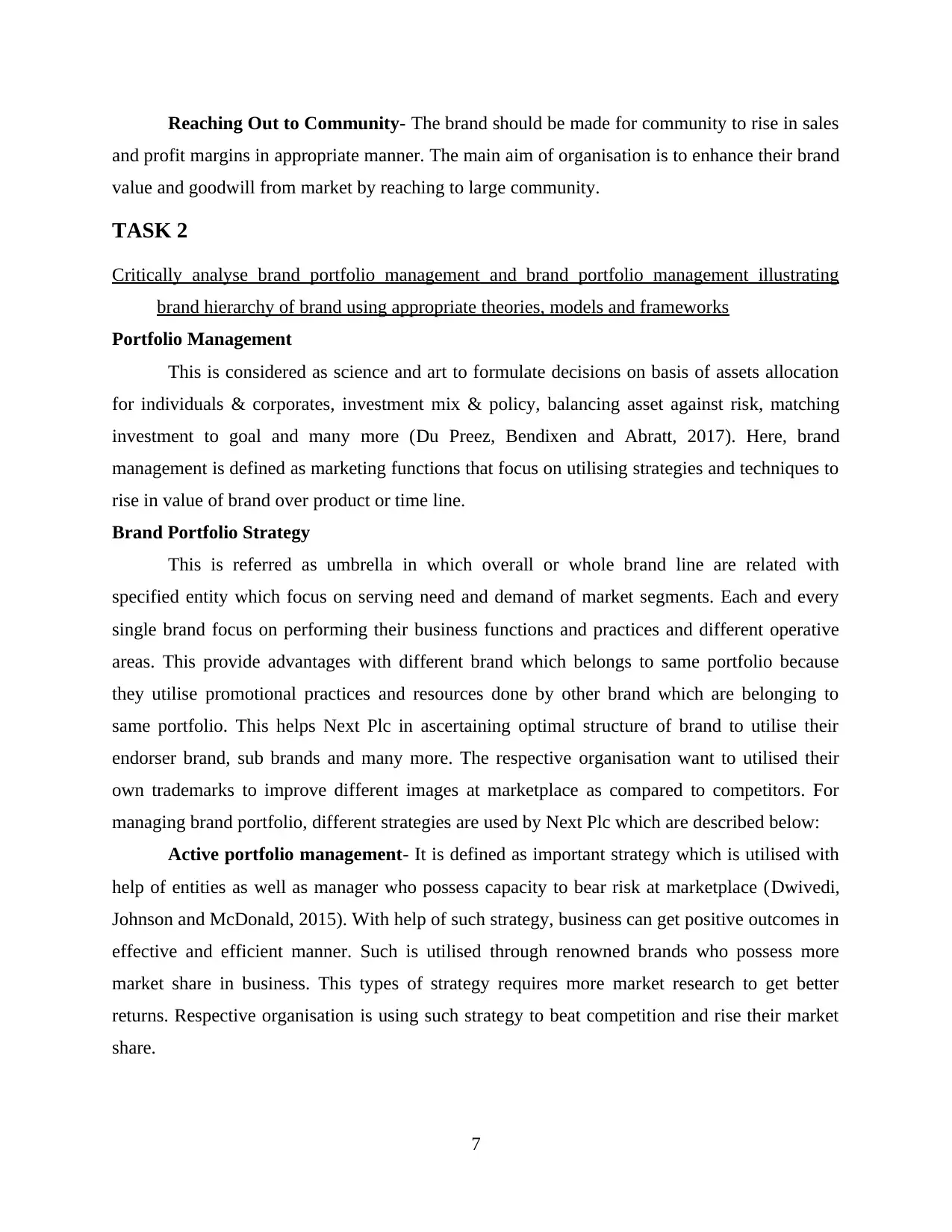
Reaching Out to Community- The brand should be made for community to rise in sales
and profit margins in appropriate manner. The main aim of organisation is to enhance their brand
value and goodwill from market by reaching to large community.
TASK 2
Critically analyse brand portfolio management and brand portfolio management illustrating
brand hierarchy of brand using appropriate theories, models and frameworks
Portfolio Management
This is considered as science and art to formulate decisions on basis of assets allocation
for individuals & corporates, investment mix & policy, balancing asset against risk, matching
investment to goal and many more (Du Preez, Bendixen and Abratt, 2017). Here, brand
management is defined as marketing functions that focus on utilising strategies and techniques to
rise in value of brand over product or time line.
Brand Portfolio Strategy
This is referred as umbrella in which overall or whole brand line are related with
specified entity which focus on serving need and demand of market segments. Each and every
single brand focus on performing their business functions and practices and different operative
areas. This provide advantages with different brand which belongs to same portfolio because
they utilise promotional practices and resources done by other brand which are belonging to
same portfolio. This helps Next Plc in ascertaining optimal structure of brand to utilise their
endorser brand, sub brands and many more. The respective organisation want to utilised their
own trademarks to improve different images at marketplace as compared to competitors. For
managing brand portfolio, different strategies are used by Next Plc which are described below:
Active portfolio management- It is defined as important strategy which is utilised with
help of entities as well as manager who possess capacity to bear risk at marketplace (Dwivedi,
Johnson and McDonald, 2015). With help of such strategy, business can get positive outcomes in
effective and efficient manner. Such is utilised through renowned brands who possess more
market share in business. This types of strategy requires more market research to get better
returns. Respective organisation is using such strategy to beat competition and rise their market
share.
7
and profit margins in appropriate manner. The main aim of organisation is to enhance their brand
value and goodwill from market by reaching to large community.
TASK 2
Critically analyse brand portfolio management and brand portfolio management illustrating
brand hierarchy of brand using appropriate theories, models and frameworks
Portfolio Management
This is considered as science and art to formulate decisions on basis of assets allocation
for individuals & corporates, investment mix & policy, balancing asset against risk, matching
investment to goal and many more (Du Preez, Bendixen and Abratt, 2017). Here, brand
management is defined as marketing functions that focus on utilising strategies and techniques to
rise in value of brand over product or time line.
Brand Portfolio Strategy
This is referred as umbrella in which overall or whole brand line are related with
specified entity which focus on serving need and demand of market segments. Each and every
single brand focus on performing their business functions and practices and different operative
areas. This provide advantages with different brand which belongs to same portfolio because
they utilise promotional practices and resources done by other brand which are belonging to
same portfolio. This helps Next Plc in ascertaining optimal structure of brand to utilise their
endorser brand, sub brands and many more. The respective organisation want to utilised their
own trademarks to improve different images at marketplace as compared to competitors. For
managing brand portfolio, different strategies are used by Next Plc which are described below:
Active portfolio management- It is defined as important strategy which is utilised with
help of entities as well as manager who possess capacity to bear risk at marketplace (Dwivedi,
Johnson and McDonald, 2015). With help of such strategy, business can get positive outcomes in
effective and efficient manner. Such is utilised through renowned brands who possess more
market share in business. This types of strategy requires more market research to get better
returns. Respective organisation is using such strategy to beat competition and rise their market
share.
7
Paraphrase This Document
Need a fresh take? Get an instant paraphrase of this document with our AI Paraphraser

Passive portfolio strategy- It is defined as that strategy which is utilised by those
business who are not interested to bear any type of risk but they want to improve as well as
develop themselves in best manner (Edlinger, 2015). This is important for organisation to utilise
those elements which facilitate them to get better returns. The respective strategy is not
beneficial for Next Plc as they want to take risk and want to earn high profit margins. It has to
take several risk in order to maintain brand value and goodwill of business in most effective
manner.
Hierarchy Management of Brands
It is also called as brand architecture which states framework of brand into entities. This
also focus on explaining about way or through which brand is associated with business or
distinguishing from other. It is also regarded as collected process for development of brand with
help of relation among option of brand. The brand portfolio model used by Next Plc are
described below:
Branded Properties- It is defined as strategy or model where brand manager focus on
utilising one brand out of whole products or categories (Godey and et. al., 2016). This provide
help to overall brand and concentrate upon enhancement of profits margin and sales in an
effective and efficient manner.
House of brand strategy- It is defined as strategy that describes those business which
focus on promoting whole sub brands personally to improve their brand for each and every
goods and services in an effective and efficient manner. The main focus is given to main or
original brand. This type of strategy requires huge resources to develop different branding
strategy for single sub brand. Respective organisation can adopt such strategy to promote their
brand such as Lipsy, Next Distribution and so on. This assist in rising sales performance for
overall brand.
TASK 3
Critically evaluate different techniques of brand extension and brand leverage to expand brand
over time in both domestic and international market and evaluate collaborative partnership.
Brand Extension
It is known as brand marketing mark cuffing. This contributes to exploit success as well as
brand image to raise and increase demand for both products and services in an efficient and
8
business who are not interested to bear any type of risk but they want to improve as well as
develop themselves in best manner (Edlinger, 2015). This is important for organisation to utilise
those elements which facilitate them to get better returns. The respective strategy is not
beneficial for Next Plc as they want to take risk and want to earn high profit margins. It has to
take several risk in order to maintain brand value and goodwill of business in most effective
manner.
Hierarchy Management of Brands
It is also called as brand architecture which states framework of brand into entities. This
also focus on explaining about way or through which brand is associated with business or
distinguishing from other. It is also regarded as collected process for development of brand with
help of relation among option of brand. The brand portfolio model used by Next Plc are
described below:
Branded Properties- It is defined as strategy or model where brand manager focus on
utilising one brand out of whole products or categories (Godey and et. al., 2016). This provide
help to overall brand and concentrate upon enhancement of profits margin and sales in an
effective and efficient manner.
House of brand strategy- It is defined as strategy that describes those business which
focus on promoting whole sub brands personally to improve their brand for each and every
goods and services in an effective and efficient manner. The main focus is given to main or
original brand. This type of strategy requires huge resources to develop different branding
strategy for single sub brand. Respective organisation can adopt such strategy to promote their
brand such as Lipsy, Next Distribution and so on. This assist in rising sales performance for
overall brand.
TASK 3
Critically evaluate different techniques of brand extension and brand leverage to expand brand
over time in both domestic and international market and evaluate collaborative partnership.
Brand Extension
It is known as brand marketing mark cuffing. This contributes to exploit success as well as
brand image to raise and increase demand for both products and services in an efficient and
8

productive manner. Having excellently-established brand name is very essential for companies
so that consumers feel drawn to purchasing goods and services (Punjaisri and Wilson, 2017). In
the aspect of effective brand extension, there are vital range of strategies that are implemented by
above mentioned company Next Plc are as follows such as:
Re-positioning same product in a different form – In this strategy, the corresponding
company can do brand extension by re-positioning their product through different forms
so that they can efficiently retain huge numbers of people. For instance, Cadbury
company is re-positioning their products in accordance of any specific festival, targeted
range of customers. As well as the above company can apply this approach in order to do
branding of their products. It can be beneficial for them as under this, they will not
require to produce any product as well as this will be cost effectively for them. One of the
key benefit of this approach is that they will not need any specific plan to implement a
well as customers will be aware from their product. Due to this, they will not need any
expansion on the marketing.
Re-positioning different product in the same form- In this strategy, their specific
commodity must be repositioned in the same way by the corresponding organization.
This is being considered as an effective way of doing branding at lower cost (Rutter,
Roper and Lettice, 2016). This is so because in it companies do not require to do higher
expense. Hence, the above mentioned company can do marketing of their different
products without making any big changes in their strategies and policies. For instance, in
the context of clothing sector there are a vital range of products for particular gender such
as for male-female, traditional and western culture etc.
New distributor, franchise or relationships- The above mentioned company is needed
to find out new franchise in order to do expansion of brand effectively. It can be
beneficial for them to discover a new market segment in which they can create new
customer range. So overall, it can be an effective strategy for above company to do brand
expansion.
Brand name or design change- Another way for brand expansion is making a famous
brand or by changing design. For implementation of this strategy, companies need huge
amount of time period so that a brand image can be created in the external environment
9
so that consumers feel drawn to purchasing goods and services (Punjaisri and Wilson, 2017). In
the aspect of effective brand extension, there are vital range of strategies that are implemented by
above mentioned company Next Plc are as follows such as:
Re-positioning same product in a different form – In this strategy, the corresponding
company can do brand extension by re-positioning their product through different forms
so that they can efficiently retain huge numbers of people. For instance, Cadbury
company is re-positioning their products in accordance of any specific festival, targeted
range of customers. As well as the above company can apply this approach in order to do
branding of their products. It can be beneficial for them as under this, they will not
require to produce any product as well as this will be cost effectively for them. One of the
key benefit of this approach is that they will not need any specific plan to implement a
well as customers will be aware from their product. Due to this, they will not need any
expansion on the marketing.
Re-positioning different product in the same form- In this strategy, their specific
commodity must be repositioned in the same way by the corresponding organization.
This is being considered as an effective way of doing branding at lower cost (Rutter,
Roper and Lettice, 2016). This is so because in it companies do not require to do higher
expense. Hence, the above mentioned company can do marketing of their different
products without making any big changes in their strategies and policies. For instance, in
the context of clothing sector there are a vital range of products for particular gender such
as for male-female, traditional and western culture etc.
New distributor, franchise or relationships- The above mentioned company is needed
to find out new franchise in order to do expansion of brand effectively. It can be
beneficial for them to discover a new market segment in which they can create new
customer range. So overall, it can be an effective strategy for above company to do brand
expansion.
Brand name or design change- Another way for brand expansion is making a famous
brand or by changing design. For implementation of this strategy, companies need huge
amount of time period so that a brand image can be created in the external environment
9
⊘ This is a preview!⊘
Do you want full access?
Subscribe today to unlock all pages.

Trusted by 1+ million students worldwide
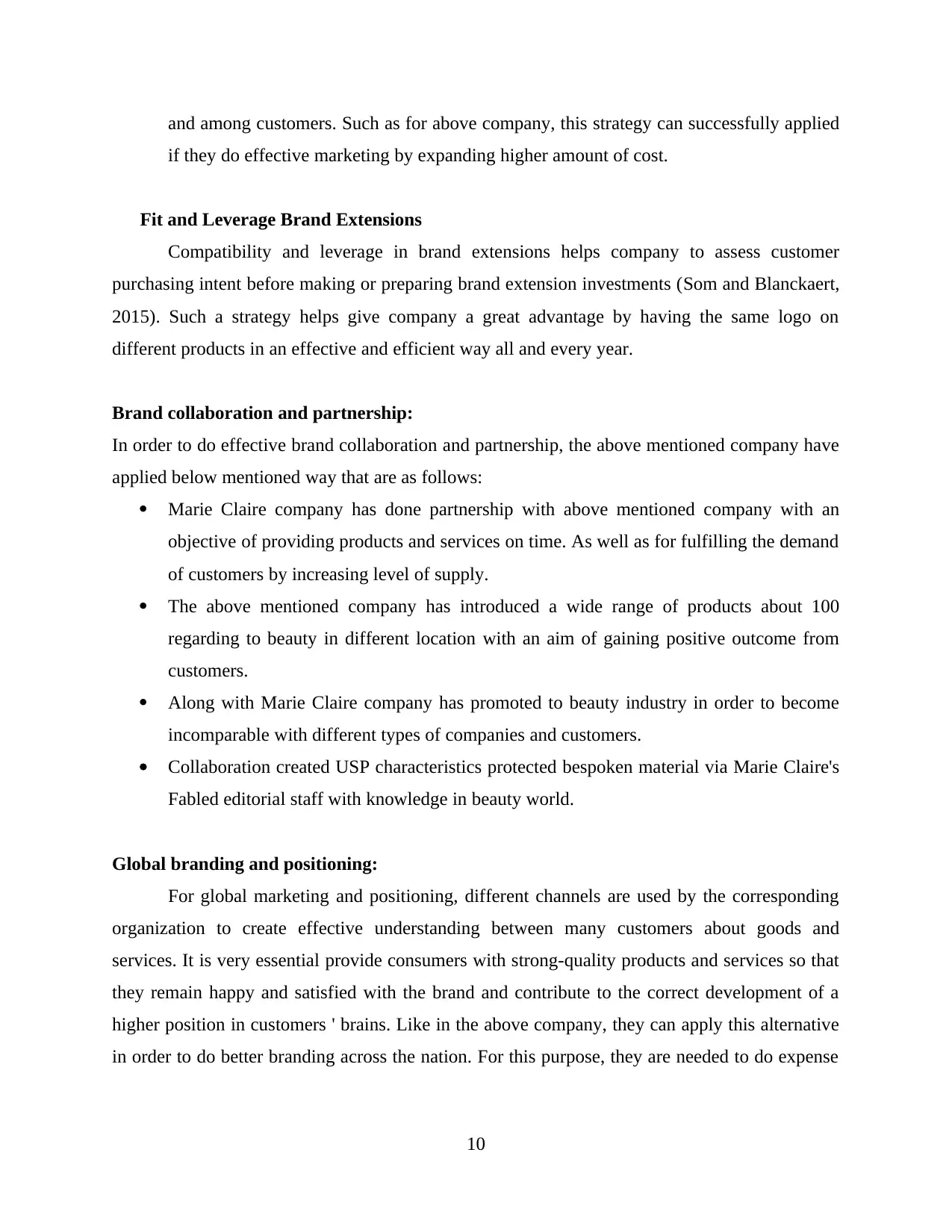
and among customers. Such as for above company, this strategy can successfully applied
if they do effective marketing by expanding higher amount of cost.
Fit and Leverage Brand Extensions
Compatibility and leverage in brand extensions helps company to assess customer
purchasing intent before making or preparing brand extension investments (Som and Blanckaert,
2015). Such a strategy helps give company a great advantage by having the same logo on
different products in an effective and efficient way all and every year.
Brand collaboration and partnership:
In order to do effective brand collaboration and partnership, the above mentioned company have
applied below mentioned way that are as follows:
Marie Claire company has done partnership with above mentioned company with an
objective of providing products and services on time. As well as for fulfilling the demand
of customers by increasing level of supply.
The above mentioned company has introduced a wide range of products about 100
regarding to beauty in different location with an aim of gaining positive outcome from
customers.
Along with Marie Claire company has promoted to beauty industry in order to become
incomparable with different types of companies and customers.
Collaboration created USP characteristics protected bespoken material via Marie Claire's
Fabled editorial staff with knowledge in beauty world.
Global branding and positioning:
For global marketing and positioning, different channels are used by the corresponding
organization to create effective understanding between many customers about goods and
services. It is very essential provide consumers with strong-quality products and services so that
they remain happy and satisfied with the brand and contribute to the correct development of a
higher position in customers ' brains. Like in the above company, they can apply this alternative
in order to do better branding across the nation. For this purpose, they are needed to do expense
10
if they do effective marketing by expanding higher amount of cost.
Fit and Leverage Brand Extensions
Compatibility and leverage in brand extensions helps company to assess customer
purchasing intent before making or preparing brand extension investments (Som and Blanckaert,
2015). Such a strategy helps give company a great advantage by having the same logo on
different products in an effective and efficient way all and every year.
Brand collaboration and partnership:
In order to do effective brand collaboration and partnership, the above mentioned company have
applied below mentioned way that are as follows:
Marie Claire company has done partnership with above mentioned company with an
objective of providing products and services on time. As well as for fulfilling the demand
of customers by increasing level of supply.
The above mentioned company has introduced a wide range of products about 100
regarding to beauty in different location with an aim of gaining positive outcome from
customers.
Along with Marie Claire company has promoted to beauty industry in order to become
incomparable with different types of companies and customers.
Collaboration created USP characteristics protected bespoken material via Marie Claire's
Fabled editorial staff with knowledge in beauty world.
Global branding and positioning:
For global marketing and positioning, different channels are used by the corresponding
organization to create effective understanding between many customers about goods and
services. It is very essential provide consumers with strong-quality products and services so that
they remain happy and satisfied with the brand and contribute to the correct development of a
higher position in customers ' brains. Like in the above company, they can apply this alternative
in order to do better branding across the nation. For this purpose, they are needed to do expense
10
Paraphrase This Document
Need a fresh take? Get an instant paraphrase of this document with our AI Paraphraser
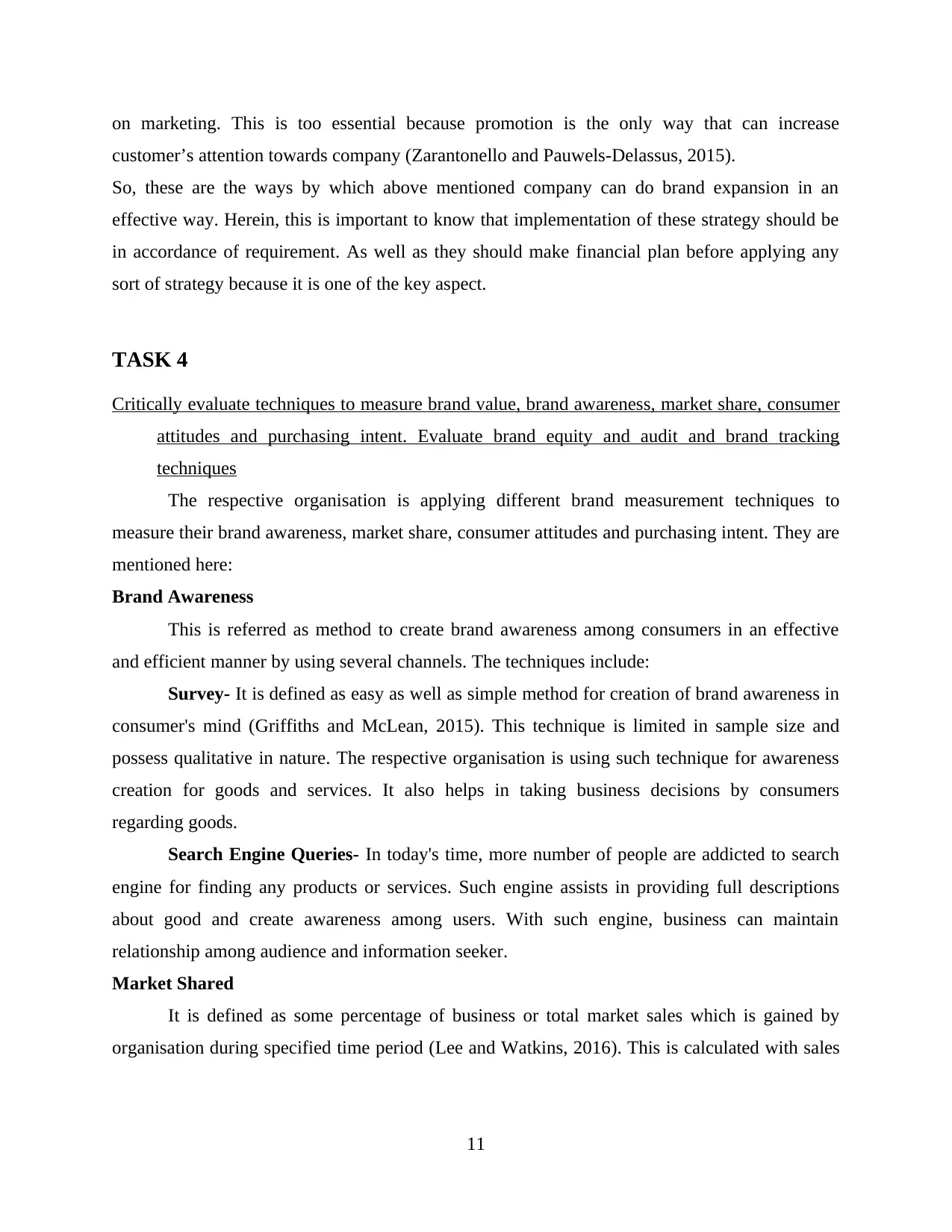
on marketing. This is too essential because promotion is the only way that can increase
customer’s attention towards company (Zarantonello and Pauwels-Delassus, 2015).
So, these are the ways by which above mentioned company can do brand expansion in an
effective way. Herein, this is important to know that implementation of these strategy should be
in accordance of requirement. As well as they should make financial plan before applying any
sort of strategy because it is one of the key aspect.
TASK 4
Critically evaluate techniques to measure brand value, brand awareness, market share, consumer
attitudes and purchasing intent. Evaluate brand equity and audit and brand tracking
techniques
The respective organisation is applying different brand measurement techniques to
measure their brand awareness, market share, consumer attitudes and purchasing intent. They are
mentioned here:
Brand Awareness
This is referred as method to create brand awareness among consumers in an effective
and efficient manner by using several channels. The techniques include:
Survey- It is defined as easy as well as simple method for creation of brand awareness in
consumer's mind (Griffiths and McLean, 2015). This technique is limited in sample size and
possess qualitative in nature. The respective organisation is using such technique for awareness
creation for goods and services. It also helps in taking business decisions by consumers
regarding goods.
Search Engine Queries- In today's time, more number of people are addicted to search
engine for finding any products or services. Such engine assists in providing full descriptions
about good and create awareness among users. With such engine, business can maintain
relationship among audience and information seeker.
Market Shared
It is defined as some percentage of business or total market sales which is gained by
organisation during specified time period (Lee and Watkins, 2016). This is calculated with sales
11
customer’s attention towards company (Zarantonello and Pauwels-Delassus, 2015).
So, these are the ways by which above mentioned company can do brand expansion in an
effective way. Herein, this is important to know that implementation of these strategy should be
in accordance of requirement. As well as they should make financial plan before applying any
sort of strategy because it is one of the key aspect.
TASK 4
Critically evaluate techniques to measure brand value, brand awareness, market share, consumer
attitudes and purchasing intent. Evaluate brand equity and audit and brand tracking
techniques
The respective organisation is applying different brand measurement techniques to
measure their brand awareness, market share, consumer attitudes and purchasing intent. They are
mentioned here:
Brand Awareness
This is referred as method to create brand awareness among consumers in an effective
and efficient manner by using several channels. The techniques include:
Survey- It is defined as easy as well as simple method for creation of brand awareness in
consumer's mind (Griffiths and McLean, 2015). This technique is limited in sample size and
possess qualitative in nature. The respective organisation is using such technique for awareness
creation for goods and services. It also helps in taking business decisions by consumers
regarding goods.
Search Engine Queries- In today's time, more number of people are addicted to search
engine for finding any products or services. Such engine assists in providing full descriptions
about good and create awareness among users. With such engine, business can maintain
relationship among audience and information seeker.
Market Shared
It is defined as some percentage of business or total market sales which is gained by
organisation during specified time period (Lee and Watkins, 2016). This is calculated with sales
11
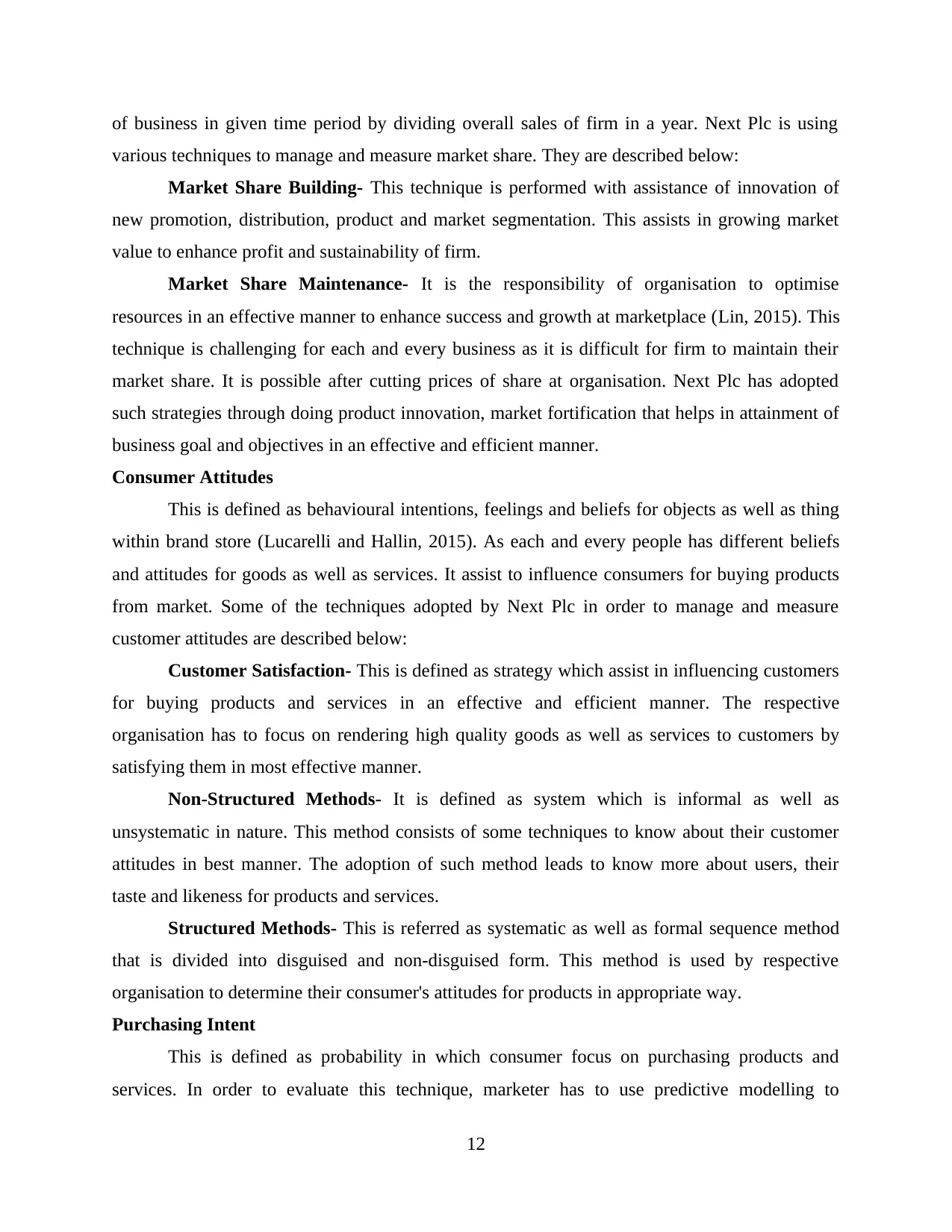
of business in given time period by dividing overall sales of firm in a year. Next Plc is using
various techniques to manage and measure market share. They are described below:
Market Share Building- This technique is performed with assistance of innovation of
new promotion, distribution, product and market segmentation. This assists in growing market
value to enhance profit and sustainability of firm.
Market Share Maintenance- It is the responsibility of organisation to optimise
resources in an effective manner to enhance success and growth at marketplace (Lin, 2015). This
technique is challenging for each and every business as it is difficult for firm to maintain their
market share. It is possible after cutting prices of share at organisation. Next Plc has adopted
such strategies through doing product innovation, market fortification that helps in attainment of
business goal and objectives in an effective and efficient manner.
Consumer Attitudes
This is defined as behavioural intentions, feelings and beliefs for objects as well as thing
within brand store (Lucarelli and Hallin, 2015). As each and every people has different beliefs
and attitudes for goods as well as services. It assist to influence consumers for buying products
from market. Some of the techniques adopted by Next Plc in order to manage and measure
customer attitudes are described below:
Customer Satisfaction- This is defined as strategy which assist in influencing customers
for buying products and services in an effective and efficient manner. The respective
organisation has to focus on rendering high quality goods as well as services to customers by
satisfying them in most effective manner.
Non-Structured Methods- It is defined as system which is informal as well as
unsystematic in nature. This method consists of some techniques to know about their customer
attitudes in best manner. The adoption of such method leads to know more about users, their
taste and likeness for products and services.
Structured Methods- This is referred as systematic as well as formal sequence method
that is divided into disguised and non-disguised form. This method is used by respective
organisation to determine their consumer's attitudes for products in appropriate way.
Purchasing Intent
This is defined as probability in which consumer focus on purchasing products and
services. In order to evaluate this technique, marketer has to use predictive modelling to
12
various techniques to manage and measure market share. They are described below:
Market Share Building- This technique is performed with assistance of innovation of
new promotion, distribution, product and market segmentation. This assists in growing market
value to enhance profit and sustainability of firm.
Market Share Maintenance- It is the responsibility of organisation to optimise
resources in an effective manner to enhance success and growth at marketplace (Lin, 2015). This
technique is challenging for each and every business as it is difficult for firm to maintain their
market share. It is possible after cutting prices of share at organisation. Next Plc has adopted
such strategies through doing product innovation, market fortification that helps in attainment of
business goal and objectives in an effective and efficient manner.
Consumer Attitudes
This is defined as behavioural intentions, feelings and beliefs for objects as well as thing
within brand store (Lucarelli and Hallin, 2015). As each and every people has different beliefs
and attitudes for goods as well as services. It assist to influence consumers for buying products
from market. Some of the techniques adopted by Next Plc in order to manage and measure
customer attitudes are described below:
Customer Satisfaction- This is defined as strategy which assist in influencing customers
for buying products and services in an effective and efficient manner. The respective
organisation has to focus on rendering high quality goods as well as services to customers by
satisfying them in most effective manner.
Non-Structured Methods- It is defined as system which is informal as well as
unsystematic in nature. This method consists of some techniques to know about their customer
attitudes in best manner. The adoption of such method leads to know more about users, their
taste and likeness for products and services.
Structured Methods- This is referred as systematic as well as formal sequence method
that is divided into disguised and non-disguised form. This method is used by respective
organisation to determine their consumer's attitudes for products in appropriate way.
Purchasing Intent
This is defined as probability in which consumer focus on purchasing products and
services. In order to evaluate this technique, marketer has to use predictive modelling to
12
⊘ This is a preview!⊘
Do you want full access?
Subscribe today to unlock all pages.

Trusted by 1+ million students worldwide
1 out of 16
Related Documents
Your All-in-One AI-Powered Toolkit for Academic Success.
+13062052269
info@desklib.com
Available 24*7 on WhatsApp / Email
![[object Object]](/_next/static/media/star-bottom.7253800d.svg)
Unlock your academic potential
Copyright © 2020–2025 A2Z Services. All Rights Reserved. Developed and managed by ZUCOL.


